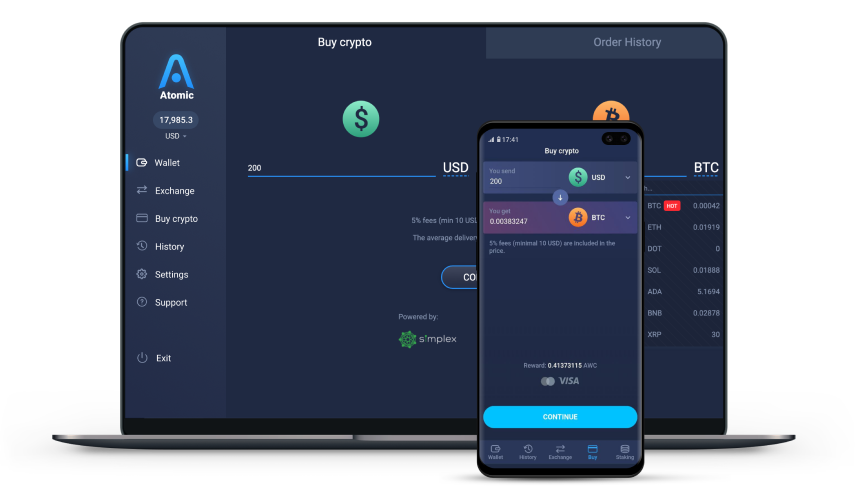Buy Tether (USDT) with Credit Card
Buy USDT with a debit or credit card, bank transfer, PayPal, Visa, or Apple Pay – fast and secure, straight into your app.




Buy Tether (USDT) and 20+ Popular Coins in One Place
You can get Bitcoin, Ethereum, SOL, ADA and more than 20+ popular coins instantly with your card, worldwide.
Why Users Are Buying Tether (USDT) Today
USDT is a stablecoin backed by reserves and widely used for fast, low-cost transfers and crypto trading. Many users buy Tether to avoid volatility and move funds easily across platforms.

Lightning-Fast Transactions
Tether moves quickly across chains and platforms, helping users avoid volatility with seamless transfers.

Low Fees
Transaction costs are minimal, making USDT ideal for frequent sending and trading.

Trusted and Widely Available
With high liquidity and support on most exchanges and wallets, Tether is one of the most accessible cryptocurrencies.
Payment methods

Buy USDT with Credit/Debit Card
Purchase USDT instantly using your credit or debit card. Visa and Mastercard supported.

Buy USDT with Bank Transfer
Link your bank account to securely buy Tether via SEPA or SWIFT.

Buy USDT with PayPal
Use your PayPal account for a fast, secure purchase.

Buy USDT with Google Pay
Google Pay enables instant buying for Android users.

Buy USDT with Apple Pay
iOS users can enjoy a seamless checkout experience using Apple Pay.
What Our Customers Say
Ava Martinez


Needed a fast and safe way to buy Tether – this app delivered exactly that.
Lucas Braun


Used PayPal to get USDT with no problems. Fast, clear, and smooth process.
Elin Petrov


Atomic makes it super easy to grab Tether quickly. Love how intuitive the app is.
Stake and Earn Rewards
Don’t let your crypto sit idle. Use Tether in DeFi or lending protocols and earn passive income while keeping your funds stable.
Stake now

Swap Instantly & Earn Cashback
Once you get Tether, swap it for 60+ coins instantly, privately, and with ease. Every swap gives you 1% cashback.
Swap nowGet Even More Crypto
Grow your portfolio in seconds. Buy Tether with your card and access the most popular coins – all in one app
Buy crypto
FAQ
Got questions about buying Tether? Here’s everything you need to know before getting started with Atomic Wallet.
[email protected]What is the easiest way to buy Tether(USDT)?
The easiest way to buy Tether is through Atomic Wallet. Just install the app, complete a quick ID verification, choose Tether from the list, and pay using your preferred method. Your USDT will be delivered to your account in minutes – securely and hassle-free.
Can I buy Tether (USDT) instantly with a credit or debit card?
Yes, Atomic Wallet lets you purchase USDT instantly using your credit or debit card. Visa, Mastercard, and other major providers are supported. It’s one of the fastest and most convenient ways to get started with USDT. Atomic supports major providers including Visa – allowing you to buy Tether with Visa effortlessly.
Is it safe to buy Tether (USDT) online through Atomic Wallet?
Absolutely. All purchases are processed through trusted, licensed EU and US payment providers. Your transaction is encrypted, and your funds are sent directly to your wallet. No third-party custody, no compromises!
How long does it take to receive Tether (USDT) after purchase?
Most USDT purchases are completed within 5 to 15 minutes. Processing time depends on your selected payment method, but in most cases, your USDT will arrive almost instantly.
Do I need a wallet to buy and store Tether(USDT)?
Yes, and that’s why the Atomic Wallet is ideal. It automatically creates a secure, non-custodial wallet when you sign up. You retain full control of your USDT from the moment you buy it.
Can I get Tether(USDT) with PayPal, Apple Pay, or Google Pay?
Yes, you can buy Tether with PayPal, depending on your region and selected provider. Just choose the method that works best for you at checkout. Apple Pay and Apple Cash are both supported, so you can buy Tether with Apple Cash right from your iPhone.
Are there any fees when buying Tether (USDT) through Atomic Wallet?
Yes, third-party providers apply a small processing fee for handling transactions. All fees are shown clearly before confirmation – there are no hidden charges, and you always know what you’ll pay.
What can I do with Tether (USDT) after buying it?
After you get Tether, you can stake it to earn rewards, swap it for over 20 other coins, or use it in DeFi apps, NFT marketplaces, and Web3 games. All of this can be done directly from Atomic Wallet.














